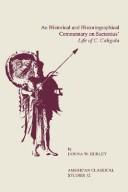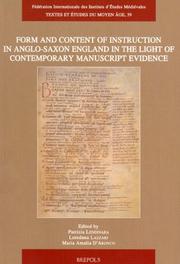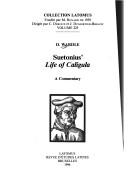| Listing 1 - 8 of 8 |
Sort by
|

ISBN: 1555408818 Year: 1993 Volume: 32 Publisher: Atlanta Scholars Press
Abstract | Keywords | Export | Availability | Bookmark
 Loading...
Loading...Choose an application
- Reference Manager
- EndNote
- RefWorks (Direct export to RefWorks)
Rome --- History --- Caligula, 37-41 --- Emperors --- Biography
Book
ISBN: 0713454873 Year: 1989 Publisher: London Batsford
Abstract | Keywords | Export | Availability | Bookmark
 Loading...
Loading...Choose an application
- Reference Manager
- EndNote
- RefWorks (Direct export to RefWorks)
Caligula --- Rome --- Kings and rulers --- Biography --- History --- Rois et souverains --- Biographie --- Histoire --- Caligula, 37-41 --- Emperors
Book
Abstract | Keywords | Export | Availability | Bookmark
 Loading...
Loading...Choose an application
- Reference Manager
- EndNote
- RefWorks (Direct export to RefWorks)
Monarchy --- Monarchie --- -321.727 <41> --- 342.37 <41> --- #KVHA:Koningshuis; Groot-Brittannie --- Kingdom (Monarchy) --- Executive power --- Political science --- Royalists --- 321.727 <41> --- British monarchy --- Monarchy, British

ISBN: 0713002077 0713040270 Year: 2000 Publisher: London Woburn
Abstract | Keywords | Export | Availability | Bookmark
 Loading...
Loading...Choose an application
- Reference Manager
- EndNote
- RefWorks (Direct export to RefWorks)
37 <09> --- 37 <41> --- 372.891 --- Human geography --- -37 <09> Geschiedenis van opvoeding en onderwijs --- Geschiedenis van opvoeding en onderwijs --- Anthropo-geography --- Anthropogeography --- Geographical distribution of humans --- Social geography --- 372.891 Aardrijkskunde. Geografie --(niet-universitair onderwijs) --- Aardrijkskunde. Geografie --(niet-universitair onderwijs) --- 37 <41> Opvoeding en onderwijs --(algemeen)--Verenigd Koninkrijk van Groot-Brittannië en Noord-Ierland --- Opvoeding en onderwijs --(algemeen)--Verenigd Koninkrijk van Groot-Brittannië en Noord-Ierland --- Study and teaching --- -Congresses --- Geography --- 37 <09> Geschiedenis van opvoeding en onderwijs --- Cosmography --- Earth sciences --- World history --- History --- Handboeken en inleidingen.

ISBN: 9782503525914 2503525911 9782503539232 Year: 2007 Volume: 39 Publisher: Turnhout: Brepols,
Abstract | Keywords | Export | Availability | Bookmark
 Loading...
Loading...Choose an application
- Reference Manager
- EndNote
- RefWorks (Direct export to RefWorks)
The essays collected in this volume focus on a prominent aspect of Anglo-Saxon culture: educational texts and the Insular manuscripts which have preserved them.The English imported manuscripts and texts from the Continent, whilst a series of foreign masters, from Theodore of Tarsus to Abbo of Fleury, brought with them knowledge of works which were being studied in Continental schools. Although monastic education played a leading role for the entire Anglo-Saxon period, it was in the second half of the tenth and early eleventh centuries that it reached its zenith, with its renewed importance and the presence of energetic masters such as Æthelwold and Ælfric. The indebtedness to Continental programs of study is evident at each step, beginning with the Disticha Catonis. Nevertheless, a number of texts initially designed for a Latin-speaking milieu appear to have been abandoned (for instance in the field of grammar) in favour of new teaching tools.Beside texts which were part of the standard curriculum, Anglo-Saxon manuscripts provide abundant evidence of other learning and teaching instruments, in particular those for a specialized class of laymen, the Old English læce, the healer or physician. Medicine occupies a relevant place in the book production of late Anglo-Saxon England and, in this field too, knowledge from very far afield was preserved and reshaped.All these essays, many by leading scholars in the various fields, explore these issues by analysing the actual manuscripts, their layout and contents. They show how miscellaneous collections of treatises in medieval codices had an internal logic, and highlight how crucial manuscripts are to the study of medieval culture.
Education, Medieval --- Manuscripts, Medieval --- Education médiévale --- Manuscrits médiévaux --- History --- Sources --- Histoire --- 091 <41> --- 091 =20 --- 37 <41> --- 091:371 --- Handschriftenkunde. Handschriftencatalogi--Verenigd Koninkrijk van Groot-Brittannië en Noord-Ierland --- Handschriftenkunde. Handschriftencatalogi--Engels --- Opvoeding en onderwijs --(algemeen)--Verenigd Koninkrijk van Groot-Brittannië en Noord-Ierland --- Handschriftenkunde. Handschriftencatalogi-:-Onderwijs. Schoolwezen --- Conferences - Meetings --- 091:371 Handschriftenkunde. Handschriftencatalogi-:-Onderwijs. Schoolwezen --- 37 <41> Opvoeding en onderwijs --(algemeen)--Verenigd Koninkrijk van Groot-Brittannië en Noord-Ierland --- 091 =20 Handschriftenkunde. Handschriftencatalogi--Engels --- 091 <41> Handschriftenkunde. Handschriftencatalogi--Verenigd Koninkrijk van Groot-Brittannië en Noord-Ierland --- Education médiévale --- Manuscrits médiévaux --- Medieval manuscripts --- Manuscripts --- Education --- Medieval education --- Seven liberal arts --- Civilization, Medieval --- Learning and scholarship --- Education [Medieval ] --- Congresses --- England --- Anglo-Saxons --- Manuscripts [Latin ] --- Sources. --- Education, Medieval - England - History - Sources - Congresses --- Manuscripts, Medieval - England - Congresses --- History, Ancient --- Ancient history --- Ancient world history --- World history
Book
ISBN: 9780754665038 9781315255064 9781351935913 9781138265790 Year: 2009 Publisher: Farnham, England ; Burlington, VT : Ashgate,
Abstract | Keywords | Export | Availability | Bookmark
 Loading...
Loading...Choose an application
- Reference Manager
- EndNote
- RefWorks (Direct export to RefWorks)
Shedding light on an important and neglected topic in childhood studies, Anja Müller interrogates how different concepts of childhood proliferated and were construed in several important eighteenth-century periodicals and satirical prints. Müller focuses on "The Tatler", "The Spectator", "The Guardian", "The Female Tatler", and "The Female Spectator", arguing that these periodicals contributed significantly to the construction, development, and popularization of childhood concepts that provided the basis for later ideas such as the 'Romantic child'. Informed by the theoretical concept of 'framing', by which certain concepts of childhood are accepted as legitimate while others are excluded, "Framing Childhood" analyses the textual and graphic constructions of the child's body, educational debates, how the shift from genealogical to affective bonding affected conceptions of parent-child relations, and how prints employed child figures as focalizers in their representations of public scenes. In examining links between text and image, Müller uncovers the role these media played in the genealogy of childhood before the 1790s, offering a re-visioning of the myth that situates the origin of childhood in late eighteenth-century England.
Children in literature. --- Children in mass media. --- Children --- Education in literature. --- Education in mass media. --- English periodicals --- English prose literature --- History --- History and criticism --- Children in literature --- Children in mass media --- Education in literature --- Education in mass media --- 094:05 --- 094:37 --- 37 <41> --- Childhood --- Kids (Children) --- Pedology (Child study) --- Youngsters --- Age groups --- Families --- Life cycle, Human --- Mass media --- Schools in literature --- Childhood in literature --- Children in poetry --- 37 <41> Opvoeding en onderwijs --(algemeen)--Verenigd Koninkrijk van Groot-Brittannië en Noord-Ierland --- Opvoeding en onderwijs --(algemeen)--Verenigd Koninkrijk van Groot-Brittannië en Noord-Ierland --- 094:37 Oude en merkwaardige drukken. Kostbare en zeldzame boeken. Preciosa en rariora-:-Opvoeding en onderwijs --(algemeen) --- Oude en merkwaardige drukken. Kostbare en zeldzame boeken. Preciosa en rariora-:-Opvoeding en onderwijs --(algemeen) --- Oude en merkwaardige drukken. Kostbare en zeldzame boeken. Preciosa en rariora--Tijdschriften

ISBN: 2870311656 9782870311653 Year: 1994 Volume: 225 Publisher: Bruxelles: Latomus,
Abstract | Keywords | Export | Availability | Bookmark
 Loading...
Loading...Choose an application
- Reference Manager
- EndNote
- RefWorks (Direct export to RefWorks)
Caligula --- Histoire et culture romaines --- Latijnse letterkunde --- Littérature latine --- Romeinse geschiedenis en cultuur --- Suetonius, --- Emperors --- Biography --- History and criticism --- Caligula, --- Rome --- History --- -Rulers --- Sovereigns --- Heads of state --- Kings and rulers --- Monarchy --- -History and criticism --- Caligula Emperor of Rome --- Suetonius --- -Emperors --- -Biography --- -Suetonius, --- Czars (Emperors) --- Rulers --- Tsars --- Tzars --- Biography&delete& --- Suetonius Tranquillus, C. --- Gaius Caesar Germanicus, --- Gaius, --- Gaius, Julius Caesar Germanicus, --- Caligola, --- Ḳaligulah, --- קאליגולאה, --- קאליגולא, --- קאליגולה --- Kaligula, --- History and criticism. --- Biography&delete&&delete& --- Emperors - Rome - Biography - History and criticism --- Suetonius, - approximately 69-approximately 122 - Caligula --- Caligula, - Emperor of Rome, - 12-41 --- Rome - History - Caligula, 37-41 --- Suetone (caius suetonius tranquillus) --- Critique et interpretation
Book
ISBN: 9780520248953 0520248953 0520287592 0520943147 1283331837 9786613331830 9780520943148 9780520287594 9781283331838 Year: 2011 Publisher: Berkeley University of California Press
Abstract | Keywords | Export | Availability | Bookmark
 Loading...
Loading...Choose an application
- Reference Manager
- EndNote
- RefWorks (Direct export to RefWorks)
The infamous emperor Caligula ruled Rome from A.D. 37 to 41 as a tyrant who ultimately became a monster. An exceptionally smart and cruelly witty man, Caligula made his contemporaries worship him as a god. He drank pearls dissolved in vinegar and ate food covered in gold leaf. He forced men and women of high rank to have sex with him, turned part of his palace into a brothel, and committed incest with his sisters. He wanted to make his horse a consul. Torture and executions were the order of the day. Both modern and ancient interpretations have concluded from this alleged evidence that Caligula was insane. But was he? This biography tells a different story of the well-known emperor. In a deft account written for a general audience, Aloys Winterling opens a new perspective on the man and his times. Basing Caligula on a thorough new assessment of the ancient sources, he sets the emperor's story into the context of the political system and the changing relations between the senate and the emperor during Caligula's time and finds a new rationality explaining his notorious brutality.
Emperors --- Caligula, --- Rome --- History --- Gaius Caesar Germanicus, --- Gaius, --- Gaius, Julius Caesar Germanicus, --- Caligola, --- Ḳaligulah, --- קאליגולאה, --- קאליגולא, --- קאליגולה --- Kaligula, --- Biography --- Emperors - Rome - Biography --- Caligula, - Emperor of Rome, - 12-41 --- Rome - History - Caligula, 37-41 --- ancient history. --- ancient rome. --- ancient sources. --- biography. --- brutality. --- caligula. --- career. --- classical period. --- dark. --- dramatic. --- engaging. --- famous tyrant. --- general audience. --- historical analysis. --- history buffs. --- history. --- human cruelty. --- intense. --- mental illness. --- military. --- nobility. --- nonfiction. --- notorious figures. --- political science. --- political system. --- political thriller. --- politics. --- questioned sanity. --- revolt. --- roman emperors. --- roman politics. --- roman senate. --- rome. --- torture. --- tyrant. --- world history. --- worship.
| Listing 1 - 8 of 8 |
Sort by
|

 Search
Search Feedback
Feedback About UniCat
About UniCat  Help
Help News
News